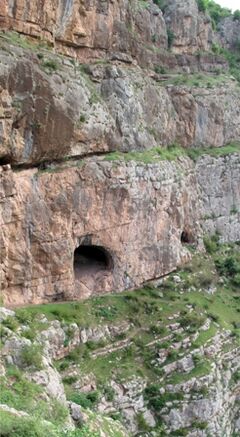History:Darband Cave
 Entrance of the Darband Cave | |
| Location | Gilan Province |
|---|---|
| Region | northern Iran |
| Coordinates | [ ⚑ ] : 36°50′08″N 49°39′32″E / 36.83556°N 49.65889°E |
| History | |
| Periods | Lower Paleolithic |
Darband Cave is a Lower Paleolithic site in the Gilan Province in northern Iran, located on the north side of a deep tributary canyon of the Siahrud River, a tributary of the Sefīd-Rūd River that flows into the Caspian Sea.
The cave contains evidence for the earliest prehistoric human cave occupation during the Lower Paleolithic in Iran. Stone artifacts and animal fossils were discovered by a group of Iranian archaeologists of the Department of Paleolithic of the National Museum of Iran and ICHTO of Gilan. The site dates back to the late Middle Pleistocene period.
The presence of large numbers of cave bear and brown bear remains and sparse stone artifacts at the site indicates that Darband primarily represents a bear den. The co-occurrence of artifacts and bear bones does not imply human predation or scavenging. Because there are no clear cut marks, except a few burning signs on the bear bones, they probably accumulated through natural processes.
References
- Biglari, F.; V. Jahani (2011). "The Pleistocene Human Settlement in Gilan, Southwest Caspian Sea: Recent Research". Eurasian Prehistory 8 (1–2): 3–28. https://www.peabody.harvard.edu/files/003_028new_opt.pdf. Retrieved 2017-02-24.
- Biglari, F.; Jahani, V.; Mashkour, M.; Argant, A.; Shidrang, S.; Taheri, K. (2007). "Darband Cave: New Evidence for Lower Paleolithic occupation at Western Alborz Range, Gilan". Paper Presented at the 11th Symposium of the Geological Society of Iran, Ferdowsi University of Mashhad, Mashhad.
- Biglari, F. and S. Shidrang (2006). "The Lower Paleolithic Occupation of Iran". Near Eastern Archaeology 69 (3–4): 160–168. doi:10.1086/NEA25067668.
23
External links



